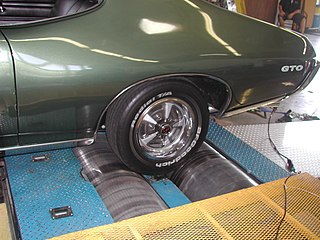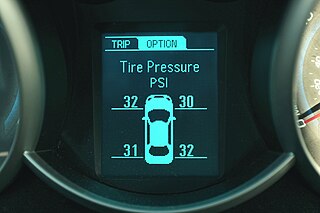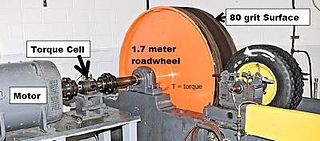
Friction is the force resisting the relative motion of solid surfaces, fluid layers, and material elements sliding against each other. Types of friction include dry, fluid, lubricated, skin, and internal -- an incomplete list. The study of the processes involved is called tribology, and has a history of more than 2000 years.

Horsepower (hp) is a unit of measurement of power, or the rate at which work is done, usually in reference to the output of engines or motors. There are many different standards and types of horsepower. Two common definitions used today are the imperial horsepower, which is about 745.7 watts, and the metric horsepower, which is approximately 735.5 watts.

A tire (en-US) or tyre (en-GB) is a ring-shaped component that surrounds a wheel's rim to transfer a vehicle's load from the axle through the wheel to the ground and to provide traction on the surface over which the wheel travels. Most tires, such as those for automobiles and bicycles, are pneumatically inflated structures, providing a flexible cushion that absorbs shock as the tire rolls over rough features on the surface. Tires provide a footprint, called a contact patch, designed to match the vehicle's weight and the bearing on the surface that it rolls over by exerting a pressure that will avoid deforming the surface.
Vehicle dynamics is the study of vehicle motion, e.g., how a vehicle's forward movement changes in response to driver inputs, propulsion system outputs, ambient conditions, air/surface/water conditions, etc. Vehicle dynamics is a part of engineering primarily based on classical mechanics. It may be applied for motorized vehicles, bicycles and motorcycles, aircraft, and watercraft.
In railway engineering, the term tractive effort describes the pulling or pushing capability of a locomotive. The published tractive force value for any vehicle may be theoretical—that is, calculated from known or implied mechanical properties—or obtained via testing under controlled conditions. The discussion herein covers the term's usage in mechanical applications in which the final stage of the power transmission system is one or more wheels in frictional contact with a railroad track.
Understeer and oversteer are vehicle dynamics terms used to describe the sensitivity of the vehicle to changes in steering angle associated with changes in lateral acceleration. This sensitivity is defined for a level road for a given steady state operating condition by the Society of Automotive Engineers (SAE) in document J670 and by the International Organization for Standardization (ISO) in document 8855. Whether the vehicle is understeer or oversteer depends on the rate of change of the understeer angle. The Understeer Angle is the amount of additional steering that must be added in any given steady-state maneuver beyond the Ackermann steer angle. The Ackermann Steer Angle is the steer angle at which the vehicle would travel about a curve when there is no lateral acceleration required.

A dynamometer or "dyno" for short, is a device for simultaneously measuring the torque and rotational speed (RPM) of an engine, motor or other rotating prime mover so that its instantaneous power may be calculated, and usually displayed by the dynamometer itself as kW or bhp.

Rolling resistance, sometimes called rolling friction or rolling drag, is the force resisting the motion when a body rolls on a surface. It is mainly caused by non-elastic effects; that is, not all the energy needed for deformation of the wheel, roadbed, etc., is recovered when the pressure is removed. Two forms of this are hysteresis losses, and permanent (plastic) deformation of the object or the surface. Note that the slippage between the wheel and the surface also results in energy dissipation. Although some researchers have included this term in rolling resistance, some suggest that this dissipation term should be treated separately from rolling resistance because it is due to the applied torque to the wheel and the resultant slip between the wheel and ground, which is called slip loss or slip resistance. In addition, only the so-called slip resistance involves friction, therefore the name "rolling friction" is to an extent a misnomer.
Traction, traction force or tractive force is a force used to generate motion between a body and a tangential surface, through the use of either dry friction or shear force. It has important applications in vehicles, as in tractive effort.
Low rolling resistance tires are designed to reduce the energy loss as a tire rolls, decreasing the required rolling effort — and in the case of automotive applications, improving vehicle fuel efficiency as approximately 5–15% of the fuel consumed by a typical gas car may be used to overcome rolling resistance.

A tire-pressure monitoring system (TPMS) monitors the air pressure inside the pneumatic tires on vehicles. A TPMS reports real-time tire-pressure information to the driver, using either a gauge, a pictogram display, or a simple low-pressure warning light. TPMS can be divided into two different types – direct (dTPMS) and indirect (iTPMS).
Tire uniformity refers to the dynamic mechanical properties of pneumatic tires as strictly defined by a set of measurement standards and test conditions accepted by global tire and car makers.
Hans Bastiaan Pacejka was an expert in vehicle system dynamics and particularly in tire dynamics, fields in which his works are now standard references. He was Professor emeritus at Delft University of Technology in Delft, Netherlands.

Energy-efficient driving techniques are used by drivers who wish to reduce their fuel consumption, and thus maximize fuel efficiency. Many drivers have the potential to improve their fuel efficiency significantly. Simple things such as keeping tires properly inflated, having a vehicle well-maintained and avoiding idling can dramatically improve fuel efficiency. Careful use of acceleration and deceleration and especially limiting use of high speeds helps efficiency. The use of multiple such techniques is called "hypermiling".

SAE J1269 is a standard test defined by the Society of Automotive Engineers to measure the rolling resistance of tires under conditions of thermal equilibrium. SAE J2452 is an alternative procedure for measuring rolling resistance under conditions similar to a vehicle coastdown event, where the tire is in a roughly isothermal condition.
Road surface textures are deviations from a planar and smooth surface, affecting the vehicle/tyre interaction. Pavement texture is divided into: microtexture with wavelengths from 0 mm to 0.5 millimetres (0.020 in), macrotexture with wavelengths from 0.5 millimetres (0.020 in) to 50 millimetres (2.0 in) and megatexture with wavelengths from 50 millimetres (2.0 in) to 500 millimetres (20 in).

Motorcycle testing and measurement includes a range of more than two dozen statistics giving the specifications of the motorcycle, and the actual performance, expressed by such things as the output of the engine, and the top speed or acceleration of the motorcycle. Most parameters are uncontroversial and claims made by manufacturers are generally accepted without verification. These might include simple measurements like rake, trail, or wheelbase, or basic features, such as the type of brakes or ignition system.

The following outline is provided as an overview of and topical guide to tires:










